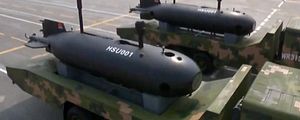On October 1, 2019, the People’s Republic of China celebrated its 70th birthday in grand fashion, complete with a lavish parade showcasing its growing national power and military might. Among the hypersonic missiles, stealth drones, and other advanced weapons and technologies on display were two somewhat unassuming unmanned undersea vehicles (UUVs) marked “HSU001.” While China has offered sneak peeks into its unmanned undersea R&D efforts before, this marked the first glimpse at a large-scale UUV program designed specifically for covert military operations.
HSU001 is a Large Displacement UUV (LDUUV), roughly analogous to the U.S. Navy’s own LDUUV, “Snakehead,” which is designed for missions such as intelligence preparation of the environment (IPOE) and anti-submarine warfare (ASW). At approximately 7 meters long, it is less than half the size of “Orca,” the U.S. Navy’s Extra Large UUV (XLUUV) which will be pier launched and is designed for complex, long-distance missions, including the delivery of specialized payloads such as mines, seabed sensors, and small UUVs. While HSU001 lacks the capacity for such large-scale payload integration, it may be capable of deploying micro UUVs or other sensors, or carrying payloads via external hardpoints. While it lacks adequate energy stores to transit thousands of nautical miles like Orca, it will likely be capable of long-endurance missions lasting several weeks to several months. Though an LDUUV, HSU001 could conceivably be pier-launched, but will more likely be deployed from surface ships or via submarine drydock shelter (DDS) as it is too large to be launched from a standard 533-millimeter torpedo tube.
A cursory examination of imagery obtained during the worldwide CCTV live broadcast suggests that, like most military-grade UUVs, HSU001 appears to be a flexible platform capable of executing a range of missions. But what exactly these might be remains a matter of speculation. With its dual collapsible masts equipped with electro-optical and electromagnetic sensors, the vehicle is optimized for intelligence, surveillance, and reconnaissance (ISR). Its “twin screw” propulsion system, along with inboard vertical and horizontal stabilizers, indicate that it has been designed with a high degree of maneuverability in mind, making it ideal for littoral operations such as port infiltration, mine countermeasures, and cable tapping. Its large, bulbous nose likely houses an advanced passive sonar array to listen for enemy submarines, while an unidentified apparatus atop its vertical stabilizer could indicate a towed hydrophone array, an acoustic emitter for decoy or jamming operations, or a magnetic anomaly detector (MAD) to detect subtle changes in the Earth’s magnetic field indicating the presence of manned submarines. The vehicle appears optimized for mine warfare as well. Equipped with side scanning sonar arrays, the vehicle could detect and identify objects lying on the ocean floor, and if fitted with a warhead, HSU001 would become a mobile, autonomous mine itself, capable of striking surface, subsurface, and seabed targets.
Although HSU001 has been referred to as an “autonomous” undersea vehicle, the extent to which artificial intelligence has been successfully integrated into HSU001 cannot be known for certain. To be sure, China is making great strides in AI, but even so, any onboard processing and decision making capabilities, while surely sophisticated, would likely be limited to advanced algorithms, leaving HSU001 at best semi-autonomous, and largely reliant upon periodic communication with a handler “in the loop.” A related, more pressing question is whether and to what extent People’s Liberation Army Navy (PLAN) handlers can communicate with HSU001. In 2017, Xinhua reported that the Chinese Academy of Sciences had successfully communicated in real-time with a network of 12 Haiyi gliders operating in the South China Sea. If true, this would represent a significant technological breakthrough, and a potential game-changer for China’s undersea warfare capability.
Given its size and flexibility, HSU001 seems ideally suited for the proposed “Great Underwater Wall,” a concept put forth by China State Shipbuilding Corporation (CSSC) in 2015. Intended to guard the South China Sea against subsurface incursions, the Great Underwater Wall is similar to the Sound Surveillance System (SOSUS), a network of seabed hydrophone arrays constructed by the United States to detect and monitor Soviet submarines during the Cold War. The Chinese version, however, would feature not only a network of stationary arrays, but also surface sensors, UUVs, and undersea power, communications, and data exfiltration systems. A network of HSU001s hovering in the water column and operating within a broader grid of stationary sensors, manned combatants, air and space assets, and land-based missiles, would significantly enhance China’s ASW and ASuW capabilities, posing a threat to anyone operating not only in the contested waters of the South China Sea, but along the Maritime Silk Road and anywhere China wishes to safeguard its maritime interests.
But while open sources suggest all of this is possible, HSU001’s actual capabilities and operational status are largely unknown. In fact, while it is entirely reasonable to assume that China unveiled a viable and fully functioning UUV on October 1, it’s also possible that the vehicle could be little more than an early-stage prototype, or even a convincing mock-up. Yet even if that were the case, the mere idea of HSU001 has enabled Beijing to secure a significant propaganda victory while simultaneously firing a shot across the collective bow of China’s adversaries. Regardless of its readiness, the message of HSU001 is clear: China will be a player in the battle for undersea dominance, and in the coming era of autonomous undersea conflict.
David R. Strachan is a naval analyst and founder of Strikepod Systems, a provider of current and strategic fiction intelligence (FICINT) and wargame designs focusing on unmanned maritime systems and autonomous undersea conflict.

































